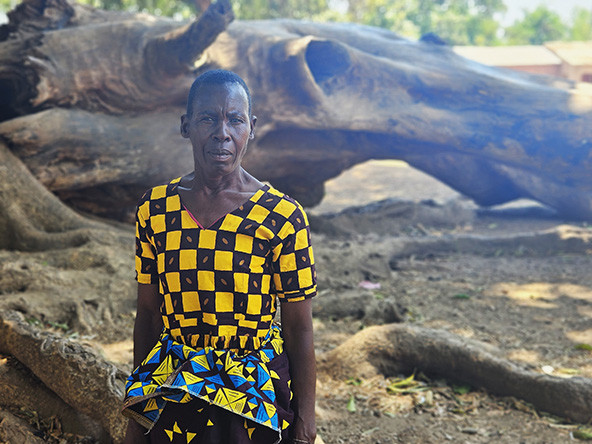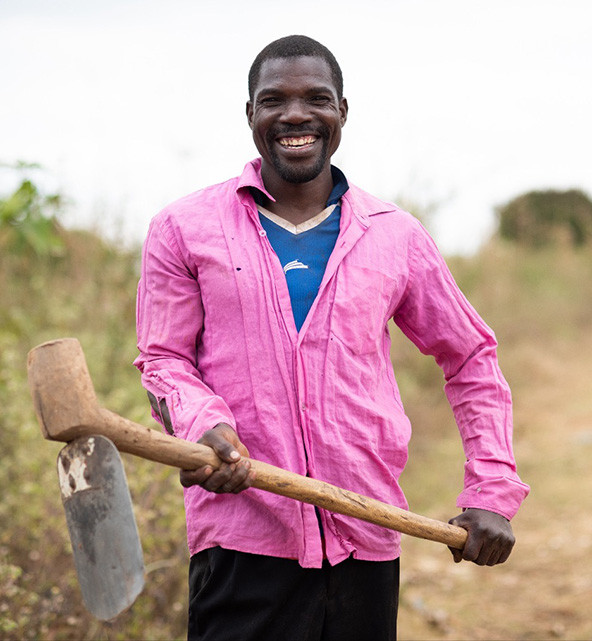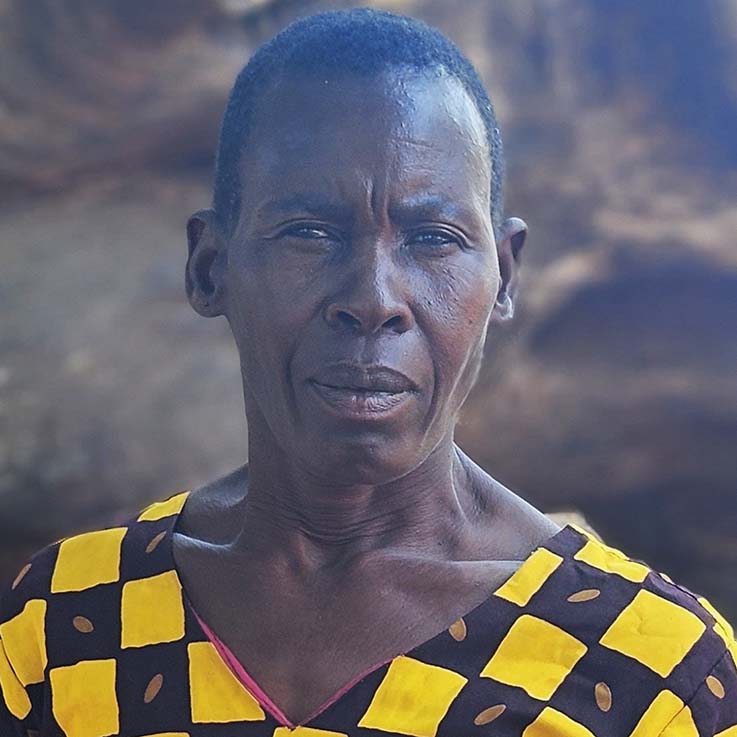
Nete Chimwaza, a Malawian farmer whose home and fields had been destroyed earlier this 12 months by Cyclone Freddy, acquired an insurance coverage payout after the storm. (Photograph by Claire McGuinness | One Acre Fund)
On the subject of adapting to local weather change, there are not any silver bullets for smallholder farmers. Constructing their long-term resilience, and thereby the resilience of the communities they feed, requires an array of instruments and approaches. Strategies like agroforestry, soil remediation, and crop diversification all have a job to play, and are comparatively established practices amongst climate-focused organizations working with smallholders in sub-Saharan Africa. However one other necessary software stays underutilized regardless of its potential: insurance coverage.
Smallholder farmers quantity 50 million sturdy in Africa alone. They contribute 80 % of the meals on the desk on the continent and account for 52 % of the employment in rural Africa. In addition they depend on rainfed agriculture to make ends meet. And as a bunch, they haven’t any buffer to soak up losses attributable to local weather shocks just like the devastating cyclone in Malawi earlier this 12 months. The standard smallholder farmer in Africa meets the usual for excessive poverty and already has to endure a season of meal skipping when their annual meals shops run out. When shocks hit, they’ve nearly no security nets to fall again on. Many are compelled to tug their youngsters from colleges they will now not pay for, take out high-interest loans, promote belongings, and endure protracted starvation. These results can reverberate for years, as farmers lack the sources to take a position in planting their subsequent season’s crops—a vicious cycle that may negatively influence an entire area’s meals safety.
At One Acre Fund, a nonprofit that helps the prosperity of farmers in Africa, we like to speak about methods farmers can assemble a “resilience protect” for themselves by climate-smart farming practices. Proper now, the parameters of a brand new paradigm-shifting Loss and Injury Fund, which can assist poorer nations adapt to the implications of local weather change, are being debated on the COP28 world convention on local weather. As these conversations proceed, it’s vital to keep in mind that insurance coverage insurance policies are an indispensable a part of this protect. Whereas it’s not at all the one security internet the fund ought to assist, insurance coverage is likely one of the handiest meals safety instruments out there. It offers farmers the arrogance they should totally make investments of their fields on the planting stage despite local weather dangers and provides safety if shocks destroy that funding. Additionally it is most impactful when it’s a part of a complete agricultural assist program. For instance, relying on the time of 12 months and whether or not seeds are nonetheless out there domestically, an insurance coverage payout within the type of re-delivered seeds that farmers can replant after the crops they initially sowed are destroyed might be way more helpful than money.
Sadly, agricultural insurance coverage doesn’t look the identical in Africa because it does within the World North. In the US, for instance, the Farm Invoice
subsidizes most of the price of agricultural insurance coverage. This public participation available in the market is broadly accepted in recognition of the social and safety imperatives to keep up a dependable home meals provide, particularly given commodities markets’ tendency to growth and bust. Against this, these subsidies are largely non-existent in Africa, the place simply 1 % of farmers have insurance coverage protection. African smallholders—who’re nearly completely depending on precipitation for his or her water wants, and on the entire lack entry to irrigation programs, drought-resistant seeds, and different resilience-strengthening instruments widespread within the World North—should make do with a lot much less safety than their counterparts. The truth is, the final narrative within the philanthropic sector is that African smallholder farmers should be capable to graduate out of assist inside 5 years or so, a normal that utterly ignores the truth that farmers in wealthy economies haven’t been capable of do the identical after a long time of assist by their governments.
Are you having fun with this text? Learn extra like this, plus SSIR’s full archive of content material, once you subscribe.
Three Market Failures
Along with the subsidization hole, three most important market failures preserve this helpful resilience software out of the palms of smallholders:
First, restricted knowledge on danger elements and farm-level outcomes, equivalent to detailed historic rainfall data to feed into local weather fashions that would inform regional crop yield predictions, makes the African insurance coverage sector expensive and susceptible to delays. Non-public insurance coverage firms shouldn’t have the danger knowledge they should supply reasonably priced premiums, and as a substitute hedge in opposition to the unknown by constructing in giant buffers. As well as, on-the-ground knowledge assortment on crop yields, flooding, and different payout triggers might be time-consuming in distant rural areas. Because of this typically payouts usually are not disbursed till lengthy after farmers have resorted to expensive coping mechanisms. These native knowledge assortment challenges additionally imply that payout selections are usually made on the regional degree, somewhat than the policyholder degree, so a smallholder may lose their whole farm to native flooding however not obtain compensation as a result of their wider space was not affected.
The second failure can also be data-related: All the sector is working in the dead of night relating to farmers’ resilience thresholds. At the moment, there may be little knowledge on what minimal earnings degree permits smallholders to keep away from coping mechanisms after shocks. With out that info, nobody can design data-backed insurance policies to reliably preserve farmers above that pink line or perceive what subsidy ranges are even wanted to supply farmers with ample assist.
Lastly, these markets are merely underdeveloped in Africa; there usually are not sufficient gamers. In a mature market, a single insurance coverage coverage is the top results of an extended chain of risk-sharing partnerships, from native brokers to native insurers to (generally a number of) re-insurers. This retains competitors wholesome and ensures that neither particular person gamers nor the market as an entire are uncovered to harmful ranges of danger. In Africa, native underwriters are functionally simply enjoying a box-checking position for firms that have to work with native companions to guarantee regulatory compliance; these native underwriters usually are not truly designing the insurance policies. That is partly on account of historic underinvestment, which has left these native gamers with out the capability to know their clients, design fit-for-purpose insurance coverage merchandise, and repair the wants of the African farmer. It’s additionally as a result of perverse incentives created by this market construction. As issues stand now, native actors can earn a revenue without having to develop their very own merchandise or take part in any important danger sharing. Subsequently, there is no such thing as a sturdy motive for them to push for a change within the present state of affairs.
In essence, many of the native insurance coverage market in Africa has needed to abandon the basic perform of underwriters to a small group of “tremendous brokers” who function at each stage of the worth chain. This permits these gamers to command unfairly excessive premium costs, together with excessive commissions and costs, whereas retaining knowledge and learnings from previous applications fenced into their very own protocols.
Altering the Smallholder Insurance coverage Market
Addressing these challenges requires that philanthropies, buyers, local weather change teams, and agricultural organizations get 4 issues proper. First, insurance coverage merchandise have to value much less and canopy extra. Bringing bills down by extra environment friendly knowledge assortment—for instance, by utilizing applied sciences like distant sensing that gather knowledge from a distance by way of instruments like satellites and drones—is one solution to obtain this. Subsidization can also be necessary. Within the World North, that is normally supplied by governments. However right here, absorbing danger whereas testing and scaling new options seems like a basic job for philanthropy, and in the long run, a perform that native governments could tackle.
One Acre Fund is saying a first-of-its-kind reinsurance fund, One Acre Fund Re, created in partnership with the Worldwide Finance Company (IFC), the US Improvement Finance Company (DFC), and African Danger Capability, to make progress in opposition to this aim. This new fund will be capable to supply farmers decrease premiums and strengthened protection, as a result of we don’t have to earn the identical margin as personal gamers and since we will leverage our historic harvest yield knowledge to right-size our danger hedging. It’s going to additionally permit us to flexibly design merchandise and direct payouts in a method that may extra successfully reply to farmers’ shock experiences. The method will likely be “open supply” in order that others, notably native insurers, can use the product growth and pricing methodology, and, as we’re planning to funnel insurance coverage income again to smallholders, subsidies will at all times find yourself within the pockets of farmers somewhat than personal firms’ financial institution accounts. Over time, we want to open this fund to others who serve smallholder farmers in order that it has sector-wide worth. We additionally hope to see different microfinance establishments undertake comparable tasks, and to be taught from various kinds of “insurance coverage affordability options” that teams like Turaco and Danger Protect are implementing.
Second, we have to perceive what earnings ranges households really want to attain resilience. One Acre Fund is presently partnering with IFC and the Microinsurance Middle at Milliman on a three-year research that may present the agricultural insurance coverage sector with strong knowledge on the earnings Malawian farmers have to get by the 12 months with out taking drastic measures—and thus, the quantity of subsidization it’ll take to get them there. Nevertheless, family earnings wants in Malawi will likely be totally different from these in nations like Nigeria, Ethiopia, and Zambia. Others have to undertake research in numerous areas in order that we will start to assemble a full image of what resilience appears to be like like on the continent.
Third, the African agricultural insurance coverage sector wants to deal with cost delays. That is one other nice use case for instruments like distant sensing, which may supply extra granular, field-specific footage of farm-level outcomes and take months off the payout timeline. Main agricultural analysis facilities CGIAR and IFPRI have additionally been doing a little revolutionary work right here not too long ago, testing totally different tech-enabled knowledge assortment approaches that add actual effectivity to the method, equivalent to self-reported cell phone footage of farmers’ crops, somewhat than in-field visits by insurance coverage brokers.
Lastly, we have to discover a solution to pull in new personal sector gamers on the availability facet by easing entry to the farmers on the demand facet. Proper now, it’s too costly for firms to ship their brokers to those distant areas to promote insurance coverage door-to-door. As an alternative, they need to start partnering with co-ops, seed suppliers, and different farmer-facing organizations which have already performed the work of pulling farmers collectively into teams. This may deliver down acquisition prices, and permit smallholder insurance coverage to make financial sense to each native and worldwide risk-carrying markets.

Drought in Malawi smallholder farmer John Handson’s space resulted within the lack of the crop he planted in 2022. As a part of his insurance coverage package deal, One Acre Fund re-delivered seeds, which he planted in time to salvage the season and keep away from catastrophic harvest losses. (Photograph by Hailey Tucker | One Acre Fund).
With COP 28 upon us, the time for motion is now. We want governments, philanthropists, farmer-facing nonprofits, distant sensing specialists, personal insurers, and local weather advocates to work collectively now to deliver down prices and enhance protection; take a look at and launch new distant sensing applied sciences; fund and conduct important knowledge assortment on farmer resilience thresholds; articulate the worth proposition of this market to non-public gamers; and spend money on consortium constructing to construct native gamers’ technical capability. Boosting the resilience of farmers depending on rainfed agriculture—who’re among the many least answerable for and essentially the most weak to local weather change—is correct in step with the worldwide local weather justice agenda.
Assist SSIR’s protection of cross-sector options to world challenges.
Assist us additional the attain of revolutionary concepts. Donate right this moment.
Learn extra tales by Claire McGuinness, Matthew Forti, Hassan Ibrahim & Johannes Borchert.
